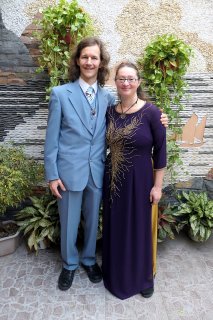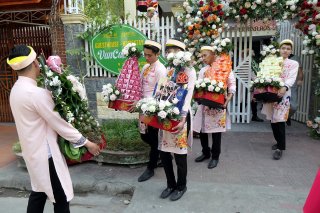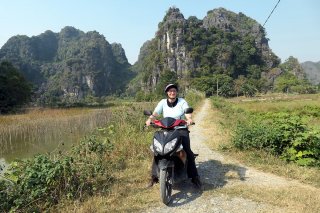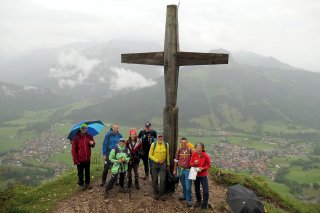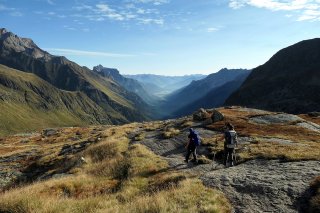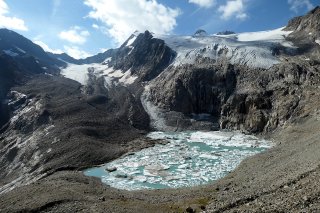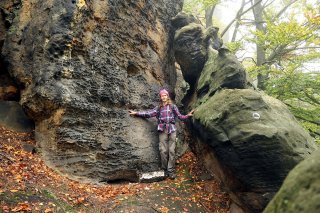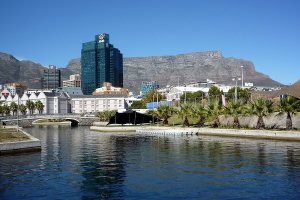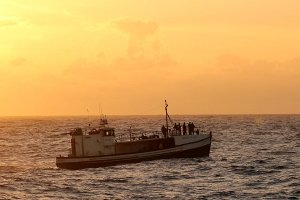Arto's Blog
Pages: 1 2 3 4 5 ...6 ...7 8 >>
Wedding in Vietnam and travels during the Corona year
Posted: 2020-12-23 17:07:00, Categories: Travel, Finland, Austria, Italy, Cycling, Germany, Hiking, Vietnam, 1324 words (permalink)Year 2020 has been unusual and affected the lives of everybody in many ways, including ours. Travelling is just one part of it but as it has been the main theme of this site for over 20 years it seems fitting to write about it also now. Some of our plans got cancelled but we still had several opportunities to get out and enjoy exploring new places as well as meeting family, friends and a few new people too. As the end of the year approaches and I haven't been active in writing during the year, what follows is a summary of the last 12 months packed in one article.
Quite exactly a year ago, in December 2019 we spent two weeks in northern Vietnam, mostly in and around Hai Phong. Normally we avoid trips that far for environmental reasons unless we have a minimum of 2-3 months to spend in the destination — which reduces the frequency of such trips quite naturally. This time we made an exception as an old school friend of mine got married and invited us to his wedding. As it later turned out, it was the last chance of travelling to distant lands for quite a long time.
The couple was Finnish-Vietnamese but the ceremonies mostly followed the local traditions. They were colourful, joyful, at times kitschy and thoroughly documented by a two-man video- and photographer team. We also took plenty of photos but due to the request of the couple won't publish any shots of them here. The host family took excellent care of us and other Finnish guests, including a day trip together to the nearby famous Halong Bay. Simultaneously it was a chance to meet and chat with old friends some of which I hadn't seen for the last 20 years. We all stayed in the same hotel and in addition to the wedding spent some time walking around in the city together.
During the second week Sandra and I headed out to the countryside, booked rooms in small guest houses and rented a small motorcycle for a few days. South-East Asia is for us an exotic but easygoing, tasty food and good mood destination. Vietnam was no exception to that and especially in the friendliness of the locals at the top end of the scale. What made the stay somewhat less enjoyable was the air pollution. Almost windstill days without rain made the otherwise postcard-like views constantly hazy and we both developed a light cough which healed again as soon as we left the country.
On the way back to Germany we stopped for three days in Dubai where we would have anyway needed to change the plane. There we sent a few CouchSurfing requests and got invited to stay with an Indian architect, a perfect match in a city filled with modern high-rise buildings and plenty more coming up. With its huge shopping malls and theme-park like attractions Dubai wasn't really our world, but interesting to explore for a couple of days. Our friendly and generous host gave us some local insight to the life there.
After that came winter and spring with cancellations and lockdowns, for us of course including plenty of day hikes on the nearby Alps. In June we were able to join our already over half a year in advance booked one week volunteer hiking guide training of the German Alpine Club DAV. It was the very first course of the summer which actually took place. Despite the rainy weather we had a good time and learned a lot in the motivated and welcoming small group lead by two excellent instructors.
Right after the hiking guide course we took advantage of the reopening of EU borders and drove to northern Italy to spend a long weekend at a mountain farm. A friend of ours from Munich takes care of the cows there every summer for a few weeks. That farm doesn't generally offer accommodation for tourists (unlike some others which do) but she is allowed to invite her friends there. Cottage life and excellent raw milk, of course. Cottage life continued in July in Finland by the lake Saimaa, where we stayed this time mainly at my aunt Pirkko's cottage. My father Timo had decided to have his old cottage taken down and a new one built, which wasn't ready yet. Due to the construction works and a few other tasks which had to be taken care of our yearly family visit wasn't as relaxing as usual. Still, we had some nice moments the highlight being a three day island-hopping tour using my father's small fishing boat. Even though the islands on Saimaa are very similar to each other it's always interesting to land on new ones where you haven't set your foot ever before and choose a spot to wild camp before it gets dark.
Allgäu and particularly our region around Füssen lives largely from tourism. Normally it's quite an international mix including a large number of Asians and Americans, all of whom couldn't come this season. On the other hand many Germans who would usually travel further away decided to spend their holidays here. Therefore the summer season was for the local hotels, guest houses and restaurants eventually not too bad. Bus tours were all cancelled but guided city walks in Füssen were allowed in small groups. Sandra joined the team in autumn 2019 so since then we're both official guides of the town.
In September Ieva, a good friend of ours joined us for a two-week hike in the Austrian and Italian Alps. We were lucky to catch a period of bombastic weather and as the main holiday season was over managed to get sleeping places in the mountain huts along our planned route. Especially the Austrian huts were quite relaxed and enjoyable to stay in, despite the new policies. Huts on the German side of the border had to comply with much more complicated regulations - the Italian ones being somewhere in between.The main part of the hike was in the Stubai Alps, starting from near Innsbruck, including a lengthy detour towards the west and descending in Sterzing/Vipiteno, followed by a couple of days in the Pfunderer Alps at the end. One main advantage of this route was staying almost constantly over 2000 meters of altitude without the need to descend deep in the valleys. That not only saved effort but also helped to mentally disconnect from the daily life "down there" during the hike.
Particularly spectacular spots included the peak of the Rinnenspitze (3000 m), the Sulzenau glacier lake and a day trip from Nürnberger hut to Ferner lakes and Roter Grat (3096 m). One trend we noticed particularly on this hike was that huts are increasingly focused on offering tasty food, in some cases fancy three or four course dinner menus as well as breakfasts in buffet style. That makes hiking trips a bit pricier as they used to be (although simpler inexpensive meals are usually available too) but the meals tend to be good value and are an enjoyable way to end the day.
Our travel season ended in October with a one and a half week cycling tour starting from Berlin. We headed first towards Wittenberg, then followed the Elbe river, stopped for two days in the historical city of Dresden and finally booked a small holiday house for three nights at the foot of the Elbe Sandstone Mountains. This time we unfortunately weren't as lucky with the weather: cloudy and rainy days with partly heavy headwinds. The last leg from Dresden towards the Czech border and the Elbe Sandstone Mountains with their fascinating rock formations was the most interesting part of the route. Due to the weather and Sandra catching a cold during the last two days we couldn't explore that area as much as we would have liked but will probably return some time in the future.
From sailing to city life in Cape Town
Posted: 2015-12-21 03:06:00, Categories: Travel, Cycling, Art, Hiking, Sailing, South Africa, 1412 words (permalink)Road through the wilderness
Posted: 2015-02-27 19:15:00, Categories: Travel, Cycling, Chile, Argentina, 1258 words (permalink)
 After our hiking trip in National Reserve Cerro Castillo we continued
cycling south on the Carretera Austral. There were no cities or major
towns any more and even villages were further and further apart from
each other. Especially the last 200 km stretch from Cochrane until
Villa O'Higgins was a small road through the wilderness, with few
houses and plenty of moors between the mountains, rivers and forests.
After our hiking trip in National Reserve Cerro Castillo we continued
cycling south on the Carretera Austral. There were no cities or major
towns any more and even villages were further and further apart from
each other. Especially the last 200 km stretch from Cochrane until
Villa O'Higgins was a small road through the wilderness, with few
houses and plenty of moors between the mountains, rivers and forests.
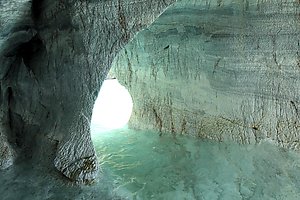 After Villa Cerro Castillo the pavement ended and the road headed
directly west for quite a while before turning south again. The next
slightly bigger settlement was Puerto Rio Tranquilo, a touristy town
famous for its marble cliffs and caves. Like most visitors, we took
a boat tour to see them. The boat spent more than half an hour near
the rock formations and went inside several of the caves, so we were
quite satisfied with the tour. The way back was like a roller
coaster ride, the small boat jumping up and down the waves on
the windy lake.
After Villa Cerro Castillo the pavement ended and the road headed
directly west for quite a while before turning south again. The next
slightly bigger settlement was Puerto Rio Tranquilo, a touristy town
famous for its marble cliffs and caves. Like most visitors, we took
a boat tour to see them. The boat spent more than half an hour near
the rock formations and went inside several of the caves, so we were
quite satisfied with the tour. The way back was like a roller
coaster ride, the small boat jumping up and down the waves on
the windy lake.
 The road followed the coast of the lake General Carrera, at times
high on top of the cliffs offering marvellous views of the lake. At
the bridge over the narrow passage between lake General Carrera and
lake Bertrand we stopped for a break. A Chilean family was enjoying
the sunny afternoon and the father started fishing using a simple
reel of line, a hook and baits. Within twenty minutes he had caught three
trouts, one weighing a bit less than a kilo and two smaller ones,
one of which he gave to us to cook for dinner.
The road followed the coast of the lake General Carrera, at times
high on top of the cliffs offering marvellous views of the lake. At
the bridge over the narrow passage between lake General Carrera and
lake Bertrand we stopped for a break. A Chilean family was enjoying
the sunny afternoon and the father started fishing using a simple
reel of line, a hook and baits. Within twenty minutes he had caught three
trouts, one weighing a bit less than a kilo and two smaller ones,
one of which he gave to us to cook for dinner.
 Following day we arrived to the southern end of lake Bertrand, where the
water was flowing out forming the beginning of the Baker river. It
was one of the most beautiful rivers on our route, with clear
blue water rushing down the valley. Some 15 kilometers
further south was the confluence of rivers Baker and Nef, where
large masses of water joined each other with great force. The water
from Nef was much more brown so Baker lost its superb colour at
that point.
Following day we arrived to the southern end of lake Bertrand, where the
water was flowing out forming the beginning of the Baker river. It
was one of the most beautiful rivers on our route, with clear
blue water rushing down the valley. Some 15 kilometers
further south was the confluence of rivers Baker and Nef, where
large masses of water joined each other with great force. The water
from Nef was much more brown so Baker lost its superb colour at
that point.
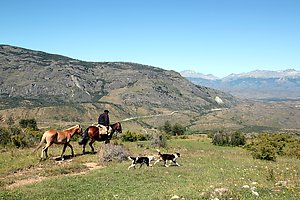 Before arriving to Cochrane, we took an alternative route on the
other side of the Baker river. In distance it was probably even a
bit shorter than the main road, but included a very steep climb of
500 meters of altitude over a pass. We had to push our bikes several times,
but enjoyed the views and the quietness of the route — during
the whole 30 km we saw only one car and a horseman.
Before arriving to Cochrane, we took an alternative route on the
other side of the Baker river. In distance it was probably even a
bit shorter than the main road, but included a very steep climb of
500 meters of altitude over a pass. We had to push our bikes several times,
but enjoyed the views and the quietness of the route — during
the whole 30 km we saw only one car and a horseman.
Cochrane was a slightly larger town than all others in the region with a couple of thousand inhabitants and a better than average selection of groceries. We bought food for a week knowing that there wouldn't be any shops during the next 230 kilometers, and headed out to the last section towards Villa O'Higgins, the southernmost point of the Carretera Austral.
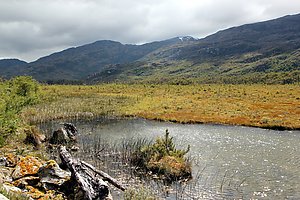 The first 40 kilometers after Cochrane was very bad gravel with a
lot of washboard, not the most enjoyable cycling experience. There
was also still a significant amount of traffic, mostly cars and
minivans heading to Caleta Tortel, a village famous of its wooden
walkways by the sea. We were not willing to cycle 25 km there and
the same way back to see the village so we skipped it and continued
directly south from the Tortel crossing.
The first 40 kilometers after Cochrane was very bad gravel with a
lot of washboard, not the most enjoyable cycling experience. There
was also still a significant amount of traffic, mostly cars and
minivans heading to Caleta Tortel, a village famous of its wooden
walkways by the sea. We were not willing to cycle 25 km there and
the same way back to see the village so we skipped it and continued
directly south from the Tortel crossing.
After the crossing of Caleta Tortel the number of cars reduced dramatically and the road became nicer and nicer. Water was flowing down from the mountains on both sides of the road in numerous small streams. There were many lakes and even more wetland, making us feel like being in Swedish or Norwegian Lapland. It was the only road through wilderness with only an occasional house every 10 or 20 kilometers, which contributed to the Lapland feeling. Although even here fences often separated the privately owned lands from the public road, there were plenty of wonderful places for wild camping.
 We came forwards a bit faster than we had anticipated and arrived in
4,5 days to Villa O'Higgins. It was a rather pleasant village or
small town, mostly living from the tourism but featuring modest
family-owned guesthouses and small grocery stores instead of hotels
and fancy restaurants. It was a dead end for everybody coming by a
motor vehicle, which meant that most didn't bother to drive that
far. There was a general sense of calmness and we heard of many people
who had stayed in the village longer than they had originally
planned. We spent three days resting and going for a couple of short
walks, and would have probably stayed for some days more if we
didn't have a certain date to be in Ushuaia, still quite a long way
further south.
We came forwards a bit faster than we had anticipated and arrived in
4,5 days to Villa O'Higgins. It was a rather pleasant village or
small town, mostly living from the tourism but featuring modest
family-owned guesthouses and small grocery stores instead of hotels
and fancy restaurants. It was a dead end for everybody coming by a
motor vehicle, which meant that most didn't bother to drive that
far. There was a general sense of calmness and we heard of many people
who had stayed in the village longer than they had originally
planned. We spent three days resting and going for a couple of short
walks, and would have probably stayed for some days more if we
didn't have a certain date to be in Ushuaia, still quite a long way
further south.
For cyclists and backpackers, it was possible to continue further from Villa O'Higgins and to cross the border to Argentina. Actually there were even two alternatives, a road and hike over the mountains to the east and a more well known ferry crossing plus hike towards the south. We chose the latter, mainly because it brought us much more directly towards Puerto Natales, where we had sent a package at the beginning of our trip to pick up later.
 One of the two ships crossing the lake O'Higgins offers a half day
side trip until the glacier carrying the same name. Compared to the
steep fare of simply getting on the other side of the lake, the
glacier tour was more reasonably priced so we decided to go for the
full package. The tour brought us close to the impressive wall of
ice several dozen meters high, with small icebergs breaking off and
floating on the lake. We had never been so close to a big
glacier before and with its various shades of blue it was more
colourful than other glaciers we had seen on the trip. As a small
surprise a glass of whisky with glacier ice was served to all
passengers. We opted for the kids' version of juice and ice,
adding alcohol to our already slightly upset stomachs after the
trip on the windy lake didn't feel like a good idea.
One of the two ships crossing the lake O'Higgins offers a half day
side trip until the glacier carrying the same name. Compared to the
steep fare of simply getting on the other side of the lake, the
glacier tour was more reasonably priced so we decided to go for the
full package. The tour brought us close to the impressive wall of
ice several dozen meters high, with small icebergs breaking off and
floating on the lake. We had never been so close to a big
glacier before and with its various shades of blue it was more
colourful than other glaciers we had seen on the trip. As a small
surprise a glass of whisky with glacier ice was served to all
passengers. We opted for the kids' version of juice and ice,
adding alcohol to our already slightly upset stomachs after the
trip on the windy lake didn't feel like a good idea.
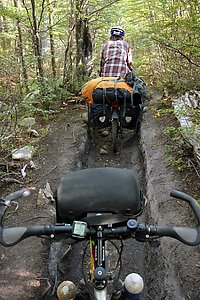 The majority of passengers returned on the ship to Villa O'Higgins,
we and a few others stepped out on the south side of the lake, where
we camped for a night before continuing. The Chilean border control
was only a few hundred meters further, the actual border with
Argentina 15 kilometers away. Until that point there was a narrow
gravel road, followed by a 6 km hiking trail leading to the Argentinian
border post at Lago Desierto. It was a scenic but pretty strenous
day, as our loaded bicycles were not the ideal vehicles for a narrow
trail going over roots and stones. However, we got through with lots
of time and patience, as all the other cyclists taking the same
route.
The majority of passengers returned on the ship to Villa O'Higgins,
we and a few others stepped out on the south side of the lake, where
we camped for a night before continuing. The Chilean border control
was only a few hundred meters further, the actual border with
Argentina 15 kilometers away. Until that point there was a narrow
gravel road, followed by a 6 km hiking trail leading to the Argentinian
border post at Lago Desierto. It was a scenic but pretty strenous
day, as our loaded bicycles were not the ideal vehicles for a narrow
trail going over roots and stones. However, we got through with lots
of time and patience, as all the other cyclists taking the same
route.
 Lake Desierto was a beautiful place for a rest day. It was free to
camp at the northern shore and during the first evening we had a
great view to the Fitz Roy mountain and other high peaks over the
lake. One day later we took another expensive ferry over to the
southern shore to avoid another longer stretch on a hiking trail
around the lake. Then it was only a 40 km easy ride to El Chalten, a
touristy town and a hub of hiking trails near and around the famous
mountains and glaciers. For us, it was the ending point of our
bicycle tour, and the beginning of a new chapter in our travels.
Lake Desierto was a beautiful place for a rest day. It was free to
camp at the northern shore and during the first evening we had a
great view to the Fitz Roy mountain and other high peaks over the
lake. One day later we took another expensive ferry over to the
southern shore to avoid another longer stretch on a hiking trail
around the lake. Then it was only a 40 km easy ride to El Chalten, a
touristy town and a hub of hiking trails near and around the famous
mountains and glaciers. For us, it was the ending point of our
bicycle tour, and the beginning of a new chapter in our travels.
Like a painted scenery
Posted: 2015-02-21 14:52:00, Categories: Travel, Cycling, Hiking, Chile, 1462 words (permalink)
 We cycle with backpacks on top of our panniers so we can stop, repack,
leave the bicycles and proceed on foot whenever we want. In National
Reserve Cerro Castillo we went hiking for half a week, mostly through
valleys but also over two mountain passes, near sharp high peaks and
glaciers. On the top of the second pass, we had a view towards the
south over hills, valleys, rivers, lakes and forests, looking like a
painting.
We cycle with backpacks on top of our panniers so we can stop, repack,
leave the bicycles and proceed on foot whenever we want. In National
Reserve Cerro Castillo we went hiking for half a week, mostly through
valleys but also over two mountain passes, near sharp high peaks and
glaciers. On the top of the second pass, we had a view towards the
south over hills, valleys, rivers, lakes and forests, looking like a
painting.
 After a couple of days in Coyhaique we continued further towards south
on the Carretera Austral. On the first day we rode through a rather
dry landscape with a strong tailwind pushing us forwards. In the best
downhill I reached 76 km/h and Sandra 66 km/h. Late afternoon just
before the village of El Blanco we stopped at a house which had
chicken running around in the garden and a sign "Eggs for
sale". We asked for six, the friendly old man packed us seven and
didn't even want to accept any payment. On the opposite side of the
road was a house selling home made cheese and we also went there to
buy some. This time we paid but got a quiet wind protected place
to camp behind the house for free.
After a couple of days in Coyhaique we continued further towards south
on the Carretera Austral. On the first day we rode through a rather
dry landscape with a strong tailwind pushing us forwards. In the best
downhill I reached 76 km/h and Sandra 66 km/h. Late afternoon just
before the village of El Blanco we stopped at a house which had
chicken running around in the garden and a sign "Eggs for
sale". We asked for six, the friendly old man packed us seven and
didn't even want to accept any payment. On the opposite side of the
road was a house selling home made cheese and we also went there to
buy some. This time we paid but got a quiet wind protected place
to camp behind the house for free.
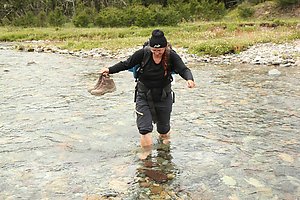 On the following day we continued towards National Reserve Cerro
Castillo and soon crossed the border of the park. The road was a
steady uphill, but paved and not too steep. A French couple in
Coyhaique had given us a hiking map of the area which they didn't
need. Around 2 pm we arrived at the starting point of one of the two
longer trails crossing the park. We checked that we had enough food
and made a rather spontaneous decision to go on the trail. We hid our
bikes and panniers between bushes, packed everything we needed in two
backpacks and started walking.
On the following day we continued towards National Reserve Cerro
Castillo and soon crossed the border of the park. The road was a
steady uphill, but paved and not too steep. A French couple in
Coyhaique had given us a hiking map of the area which they didn't
need. Around 2 pm we arrived at the starting point of one of the two
longer trails crossing the park. We checked that we had enough food
and made a rather spontaneous decision to go on the trail. We hid our
bikes and panniers between bushes, packed everything we needed in two
backpacks and started walking.
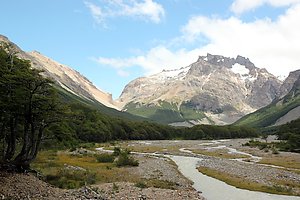 The first 15 km of the trail was relatively flat, following a river
valley through a forest. It was fairly easy walking except for several
small river crossings without bridges, which meant that we had to take
off our shoes and walk through the cold water. Sandals would have been
useful but we had left ours at the bikes to save weight. On the first
evening we walked about two thirds of the flat part and set up our
tent next to the river. Officially wild camping is not allowed in
Chilean national parks and reserves, but in less frequented areas it
is usually rather easy. We're not doing open fires and naturally not
leaving any trash behind us.
The first 15 km of the trail was relatively flat, following a river
valley through a forest. It was fairly easy walking except for several
small river crossings without bridges, which meant that we had to take
off our shoes and walk through the cold water. Sandals would have been
useful but we had left ours at the bikes to save weight. On the first
evening we walked about two thirds of the flat part and set up our
tent next to the river. Officially wild camping is not allowed in
Chilean national parks and reserves, but in less frequented areas it
is usually rather easy. We're not doing open fires and naturally not
leaving any trash behind us.
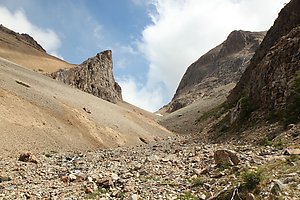 During the night and morning it was raining, but shortly before noon
the rain stopped and there were more and more openings in the clouds.
We came to the park rangers' hut and got some information about the
route ahead of us. In Chile it's even more useful to talk to the
rangers than in Europe because the maps are usually not very detailed
and often outdated. Also in this case a couple of new campsites and
one trail weren't marked on the map, and another trail which was on it
didn't exist any more.
During the night and morning it was raining, but shortly before noon
the rain stopped and there were more and more openings in the clouds.
We came to the park rangers' hut and got some information about the
route ahead of us. In Chile it's even more useful to talk to the
rangers than in Europe because the maps are usually not very detailed
and often outdated. Also in this case a couple of new campsites and
one trail weren't marked on the map, and another trail which was on it
didn't exist any more.
 After a few more kilometers through the forest next to the river the
path started climbing up towards a pass. It wasn't a very long climb,
about 500 meters of ascent on a good trail brought us to 1300 meters
of altitude. That doesn't sound very high, but it was comparable to trails a thousand meters higher in the Alps: above the treeline, windy and snow fields remaining
in places where the sun didn't shine the whole day long. A nearby
glacier reaching down to about 1500 meters of altitude was keeping the
temperature lower than it otherwise would have been. We could see the
glacier from just a couple of hundred meters away, with melting water flowing
down in numerous small streams, joining each other further down to
form a river.
After a few more kilometers through the forest next to the river the
path started climbing up towards a pass. It wasn't a very long climb,
about 500 meters of ascent on a good trail brought us to 1300 meters
of altitude. That doesn't sound very high, but it was comparable to trails a thousand meters higher in the Alps: above the treeline, windy and snow fields remaining
in places where the sun didn't shine the whole day long. A nearby
glacier reaching down to about 1500 meters of altitude was keeping the
temperature lower than it otherwise would have been. We could see the
glacier from just a couple of hundred meters away, with melting water flowing
down in numerous small streams, joining each other further down to
form a river.
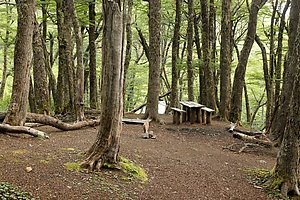 The crossing of the pass was easy, the descent on the other side rocky
and steep. It probably took us more time to go down than we had needed
to hike up. However, after an hour of carefully descending step by
step we had the steep part behind us and the trail became easier
again. It went still down for quite a while first through gravel and then through forest
before reaching the campsite. The facilities were very basic as on
every site in Cerro Castillo: some flat space to set up tents, a dry
toilet, a table and a couple of wooden benches, drinking water from
the river flowing by. We had the whole site for us, the park rangers
at the hut had been the only people we met during the whole day.
The crossing of the pass was easy, the descent on the other side rocky
and steep. It probably took us more time to go down than we had needed
to hike up. However, after an hour of carefully descending step by
step we had the steep part behind us and the trail became easier
again. It went still down for quite a while first through gravel and then through forest
before reaching the campsite. The facilities were very basic as on
every site in Cerro Castillo: some flat space to set up tents, a dry
toilet, a table and a couple of wooden benches, drinking water from
the river flowing by. We had the whole site for us, the park rangers
at the hut had been the only people we met during the whole day.
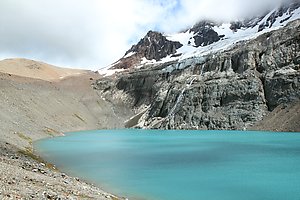 During the night and morning it was raining again but similarly to
previous day the rain stopped before noon, with a mix of sunshine,
clouds and a couple of short showers during the rest of the day. The
trail led us up to a clear mountain lake with a small meadow of green
grass on the eastern shore, gravel and rocks in all other directions.
We had a picnic by the lake and then climbed the steep and rocky slope
up to a ridge and a small highland plateau. There we met the first
other hikers since the start of our walk. It was the most famous
section of the park and there was also a shorter trail leading to the
same point, starting directly from the town of Villa Cerro Castillo.
During the night and morning it was raining again but similarly to
previous day the rain stopped before noon, with a mix of sunshine,
clouds and a couple of short showers during the rest of the day. The
trail led us up to a clear mountain lake with a small meadow of green
grass on the eastern shore, gravel and rocks in all other directions.
We had a picnic by the lake and then climbed the steep and rocky slope
up to a ridge and a small highland plateau. There we met the first
other hikers since the start of our walk. It was the most famous
section of the park and there was also a shorter trail leading to the
same point, starting directly from the town of Villa Cerro Castillo.
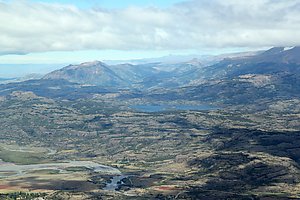 On top of the ridge we could see down to the town and over the whole
landscape towards the south. The valley of river Ibanez dominated the
foreground, behind it were hills, lakes, other rivers, patches of
forest and higher mountains in the background. The Carretera Austral
road crossed through from north to south-west with a couple of tiny
side roads starting from it. With the shadows of clouds over the land
the scenery looked almost like a painting. We sat down and watched it for a
while before continuing further on the trail.
On top of the ridge we could see down to the town and over the whole
landscape towards the south. The valley of river Ibanez dominated the
foreground, behind it were hills, lakes, other rivers, patches of
forest and higher mountains in the background. The Carretera Austral
road crossed through from north to south-west with a couple of tiny
side roads starting from it. With the shadows of clouds over the land
the scenery looked almost like a painting. We sat down and watched it for a
while before continuing further on the trail.
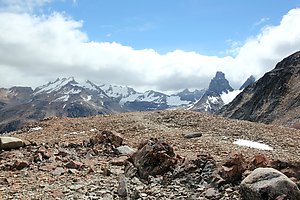 The trail went up on a shoulder of a mountain at about 1600 km of
altitude, the highest point of the hike. On our right we could see the
sharp peaks of the Cerro Castillo, partly hidden behind clouds. The
wind was blowing hard and we had to watch our steps when coming down
along the steep rocky slope on the other side. Then the trail went
again inside the forest where it was easier to walk, but still quite a
way until the campsite. Distance marked on the map was 1,4 km, which
was apparently just the straight line between the two coordinates and
had nothing to do with the actual walking distance on the path. On the
way, we met Simon, Jose and Clara, three Chileans from Santiago, and
walked together with them the last kilometers. Then it was time to set
up the tent, cook dinner and go to sleep as usual.
The trail went up on a shoulder of a mountain at about 1600 km of
altitude, the highest point of the hike. On our right we could see the
sharp peaks of the Cerro Castillo, partly hidden behind clouds. The
wind was blowing hard and we had to watch our steps when coming down
along the steep rocky slope on the other side. Then the trail went
again inside the forest where it was easier to walk, but still quite a
way until the campsite. Distance marked on the map was 1,4 km, which
was apparently just the straight line between the two coordinates and
had nothing to do with the actual walking distance on the path. On the
way, we met Simon, Jose and Clara, three Chileans from Santiago, and
walked together with them the last kilometers. Then it was time to set
up the tent, cook dinner and go to sleep as usual.
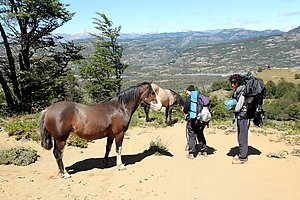 At the campsite there were a few more hikers going to different
directions. We headed down towards Villa Cerro Castillo, again
together with Simon, Jose and Clara. On the way we had a 1,5 hour
break when Simon set up his equipment and made a multi-channel
sound recording for his sound landscapes project. It was a sunny, hot
day and we were all quite tired when finally arriving to the town.
Next to the main road was a funny looking hamburger restaurant built
into two old buses. We ordered a burger each and a plate of french
fries to share. The service was slow but the burgers good and huge
— I was satisfied with one and Sandra with a half, the rest we
packed with us to eat later in the evening.
At the campsite there were a few more hikers going to different
directions. We headed down towards Villa Cerro Castillo, again
together with Simon, Jose and Clara. On the way we had a 1,5 hour
break when Simon set up his equipment and made a multi-channel
sound recording for his sound landscapes project. It was a sunny, hot
day and we were all quite tired when finally arriving to the town.
Next to the main road was a funny looking hamburger restaurant built
into two old buses. We ordered a burger each and a plate of french
fries to share. The service was slow but the burgers good and huge
— I was satisfied with one and Sandra with a half, the rest we
packed with us to eat later in the evening.
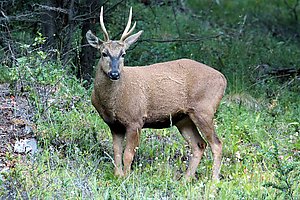 After eating we bought fresh fruits and other food at the
minimarket on the opposite side of the street, said good bye to the
Chileans and started hitchhiking back to our bikes. There were no
buses any more, only a few cars and some competition from other
hitchhikers so we had to wait for some time. Finally we managed to
convince a pickup driver that there was enough space for us at the back
and got a ride. It was a cool ride through mountain landscape in the
evening light. And we were specially lucky because two huemules (a
Chilean species of deer) were next to the road and the family in the pickup was
also enthusiastic to see them. They stopped and we got good photos.
After eating we bought fresh fruits and other food at the
minimarket on the opposite side of the street, said good bye to the
Chileans and started hitchhiking back to our bikes. There were no
buses any more, only a few cars and some competition from other
hitchhikers so we had to wait for some time. Finally we managed to
convince a pickup driver that there was enough space for us at the back
and got a ride. It was a cool ride through mountain landscape in the
evening light. And we were specially lucky because two huemules (a
Chilean species of deer) were next to the road and the family in the pickup was
also enthusiastic to see them. They stopped and we got good photos.
Back at the starting point of the trail our bikes were where we had left them behind a bush. We camped for a night, repacked our gear for cycling and continued further south along the Carretera Austral.
Seaside villages, huge leaves and roadworks on the Carretera Austral
Posted: 2015-01-31 22:48:00, Categories: Travel, Cycling, Hiking, Chile, 851 words (permalink)
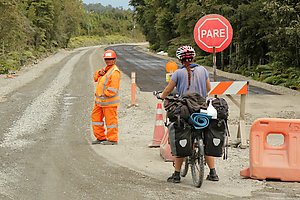 We spent 2,5 weeks in January cycling from Puerto Montt to
Coyhaique on the road number 7, better known as the Carretera
Austral. It is the main and only road leading south in this part of
Chile. Most of the villages and towns on the way are small so the
traffic wasn't heavy, and the road surface was in many parts still
gravel. However, as the only land route south it is becoming
increasingly important, and there is a big effort going on to make it
paved at least for the complete northern half until Coyhaique.
We spent 2,5 weeks in January cycling from Puerto Montt to
Coyhaique on the road number 7, better known as the Carretera
Austral. It is the main and only road leading south in this part of
Chile. Most of the villages and towns on the way are small so the
traffic wasn't heavy, and the road surface was in many parts still
gravel. However, as the only land route south it is becoming
increasingly important, and there is a big effort going on to make it
paved at least for the complete northern half until Coyhaique.
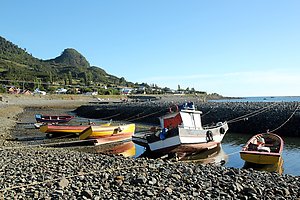 The first 60 km from Puerto Montt the road followed the seaside, a
relatively narrow passage between the island of Chiloe and the
mainland. The coast was lined with small fishing villages which looked
pretty in the late afternoon and evening sun. We camped on a small
grass field facing the sea and could see the sun setting behind
Chiloe.
The first 60 km from Puerto Montt the road followed the seaside, a
relatively narrow passage between the island of Chiloe and the
mainland. The coast was lined with small fishing villages which looked
pretty in the late afternoon and evening sun. We camped on a small
grass field facing the sea and could see the sun setting behind
Chiloe.
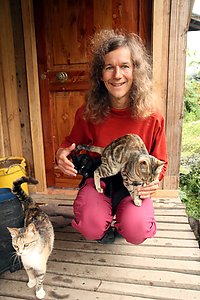 The next day we left the sea for a while and hit the first section of
roadworks: 20 km of bad gravel, dust, trucks and other machines
preparing the road for pavement, which unfortunately wasn't ready
yet. The day was saved by a very nice guesthouse where we stayed with
eleven cats, other animals including dogs, ducks and goats, and a nice
family taking care of all of them and us as guests of course. We even
got homemade bread and duck eggs to complement our dinner which we
cooked ourselves in the kitchen.
The next day we left the sea for a while and hit the first section of
roadworks: 20 km of bad gravel, dust, trucks and other machines
preparing the road for pavement, which unfortunately wasn't ready
yet. The day was saved by a very nice guesthouse where we stayed with
eleven cats, other animals including dogs, ducks and goats, and a nice
family taking care of all of them and us as guests of course. We even
got homemade bread and duck eggs to complement our dinner which we
cooked ourselves in the kitchen.
 From Hornopiren there was a 5 hour passage by two ferries until Caleta
Gonzalo, where we entered the Pumalin Nature Park. It is private land
but maintained in a similar way than national parks, with marked
hiking trails, campsites and information services. The park was full
with lush vegetation, in particular large ferns and huge wild rhubarb
leaves (nalca in spanish), some of them more than two meters across.
It was clearly a region with lots of rain and we also had our share,
but luckily also a few sunny moments between the clouds. The campsites
were beautifully arranged and the same aesthetic appearance was
carried out throughout the park, including every sign and information
board. Unlike national parks, there were no entrance fees to access
the trails, and the campsites were very modestly priced at 2500 CLP
(about 3,5) per person.
From Hornopiren there was a 5 hour passage by two ferries until Caleta
Gonzalo, where we entered the Pumalin Nature Park. It is private land
but maintained in a similar way than national parks, with marked
hiking trails, campsites and information services. The park was full
with lush vegetation, in particular large ferns and huge wild rhubarb
leaves (nalca in spanish), some of them more than two meters across.
It was clearly a region with lots of rain and we also had our share,
but luckily also a few sunny moments between the clouds. The campsites
were beautifully arranged and the same aesthetic appearance was
carried out throughout the park, including every sign and information
board. Unlike national parks, there were no entrance fees to access
the trails, and the campsites were very modestly priced at 2500 CLP
(about 3,5) per person.
 From Pumalin we came to Chaiten, where we stayed one night in a
guesthouse and refilled our food reserves in a supermarket. After
Chaiten the road was paved, relatively flat and we even had a good
tailwind for the next 40 km so it was easy cycling for a while. Then
it was gravel again, but a fairly pleasant and smooth one this time.
At Ventisquero Yelcho there was a free camping and a walking trail
leading to a glacier hanging down from the mountains.
From Pumalin we came to Chaiten, where we stayed one night in a
guesthouse and refilled our food reserves in a supermarket. After
Chaiten the road was paved, relatively flat and we even had a good
tailwind for the next 40 km so it was easy cycling for a while. Then
it was gravel again, but a fairly pleasant and smooth one this time.
At Ventisquero Yelcho there was a free camping and a walking trail
leading to a glacier hanging down from the mountains.
 We started meeting more and more cyclists on the way, most of them
travelling south as we did. The majority were Chileans, but there were
many from other parts of the world as well. One of them, Alex from
Australia, joined us for a few days. Together we did a very nice
detour in a small quiet valley leading to lake Claro Solar. With the
mountains in the background and a couple of farms with cows on the
fields it looked a lot like German or Austrian Alps.
We started meeting more and more cyclists on the way, most of them
travelling south as we did. The majority were Chileans, but there were
many from other parts of the world as well. One of them, Alex from
Australia, joined us for a few days. Together we did a very nice
detour in a small quiet valley leading to lake Claro Solar. With the
mountains in the background and a couple of farms with cows on the
fields it looked a lot like German or Austrian Alps.
 We passed the town La Junta and about 40 km later stopped in another
called Puyuhuapi, where we stayed mostly inside because of the rain
and had a rest day. The Internet was good enough to
call our families, catch up a bit on what's happening in the world
(which we rarely do on the road) and search for information about the
areas coming up. In the night there were fireworks and a dance party
to celebrate the foundation of the town about 80 years ago.
We passed the town La Junta and about 40 km later stopped in another
called Puyuhuapi, where we stayed mostly inside because of the rain
and had a rest day. The Internet was good enough to
call our families, catch up a bit on what's happening in the world
(which we rarely do on the road) and search for information about the
areas coming up. In the night there were fireworks and a dance party
to celebrate the foundation of the town about 80 years ago.
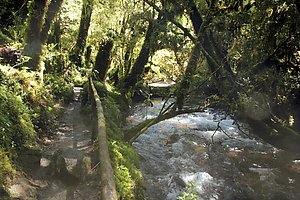 After Puyuhuapi we came to the Queulat National Park, where we saw
another glacier and had a relaxed evening with our own small campfire at
the park campground. The next day we cycled further and walked the
"Bosque encantada" (enchanted forest) trail through a
beautiful moss-covered old forest until a laguna up in the mountains.
After Puyuhuapi we came to the Queulat National Park, where we saw
another glacier and had a relaxed evening with our own small campfire at
the park campground. The next day we cycled further and walked the
"Bosque encantada" (enchanted forest) trail through a
beautiful moss-covered old forest until a laguna up in the mountains.
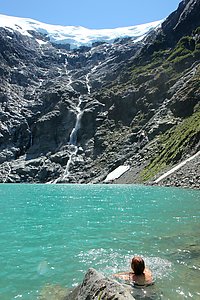 About 20 other people had also found their way there —
surprisingly many considering that the beginning of the trail was
poorly marked, and it wasn't one of the shortest nor easiest walks
either.
About 20 other people had also found their way there —
surprisingly many considering that the beginning of the trail was
poorly marked, and it wasn't one of the shortest nor easiest walks
either.
The last 180 km until Coyhaique the road was paved and not too
hilly, following river valleys between the mountains. It was sunny
again and one of the days was so hot that we had a long afternoon
break cooking in the shade and swimming in the Maniguales river.
 Traffic became heavier as we approached the city and the road was
narrow so it was probably one of the most dangerous sections of the
whole trip. Still, almost all the passing cars left us plenty of space
and we arrived safely to Coyhaique. That was a perfect place to have a
break, take a nice warm shower, get our clothes washed, communicate
with our WarmShowers hosts and prepare for the way further south.
Traffic became heavier as we approached the city and the road was
narrow so it was probably one of the most dangerous sections of the
whole trip. Still, almost all the passing cars left us plenty of space
and we arrived safely to Coyhaique. That was a perfect place to have a
break, take a nice warm shower, get our clothes washed, communicate
with our WarmShowers hosts and prepare for the way further south.

Copyright Arto Teräs <ajt@iki.fi>, licensed under the Creative Commons Attribution-Share Alike 3.0 Unported License. (Unless otherwise mentioned in individual photos or other content.)
